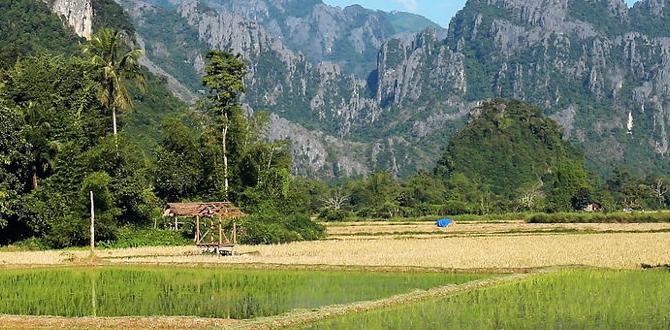Embark on a Belize self-guided food tour to savor essential flavors! Discover delicious dishes, local ingredients, and culinary traditions with this easy-to-follow guide. Experience Belize through its vibrant food scene at your own pace, from coast to jungle.
Belize is a culinary gem, a place where vibrant cultures meet to create a truly unique taste of Central America. If you’re planning a trip, you might be wondering how to best experience its incredible food scene without a guide. It can feel a bit daunting to navigate new flavors and local eateries on your own, right? Don’t worry! This guide is designed to make your Belize self-guided food tour an absolute breeze. We’ll break down the must-try dishes, essential ingredients, and smart tips for exploring. Get ready to discover the heart of Belize, one delicious bite at a time. Let’s dive into the essential flavors that make Belize so special!
Your Essential Belize Self-Guided Food Tour
Planning a self-guided food tour in Belize means embracing adventure and saying “yes” to new tastes. It’s about flexibility, curiosity, and letting your taste buds lead the way. Forget rigid schedules; think spontaneous stops at roadside kitchens and bustling market stalls. This guide will equip you with the knowledge to confidently explore Belize’s diverse culinary landscape, ensuring you don’t miss out on any of its essential flavors.
Whether you’re a seasoned traveler or embarking on your first solo adventure, understanding the local ingredients and signature dishes is key. Belize’s food is influenced by Maya, Creole, Mestizo, Garifuna, and even Asian cultures, creating a rich tapestry of tastes. This tour will focus on the foundational flavors that represent this unique blend.
What Exactly is a Self-Guided Food Tour?
Simply put, a self-guided food tour is an independent culinary exploration. Instead of following a group with a set itinerary, you create your own path. You decide where to go, what to eat, and when to eat it. It gives you the freedom to linger at places you love or skip over things that don’t appeal to you. For Belize, this means hopping between local comedores (small eateries), vibrant markets, and specialty food vendors to sample authentic dishes.
This approach allows for more spontaneous discoveries. You might stumble upon a hidden gem recommended by a friendly local or find yourself drawn to the aroma of freshly prepared food. It’s about experiencing Belize’s food culture authentically, at your own rhythm.
Why Belize is a Food Lover’s Paradise
Belize offers a remarkable culinary experience due to its diverse population and history. The country’s strategic location and historical influences have woven together a unique food narrative. You’ll find dishes that reflect the country’s indigenous Maya heritage, the vibrant Creole culture, the seafaring Garifuna people, and the hardworking Mestizo communities, with later additions from Mennonite farmers and Asian immigrants.
The abundance of fresh, local ingredients is another major draw. Think tropical fruits, freshly caught seafood, aromatic spices, and hearty staples like rice and beans. This fresh produce forms the backbone of many Belizean meals, making them both delicious and wholesome. Exploring Belize means exploring a cuisine that is as diverse and welcoming as its people.
Essential Belizean Flavors: What to Seek Out
To truly understand Belize, you need to taste its signature dishes. These aren’t just meals; they are edible stories of Belize’s history and culture. Here are some of the absolute essentials you should look for on your self-guided food tour.
1. Rice and Beans: The Undisputed Staple
You’ll find rice and beans everywhere in Belize, and for good reason. It’s comforting, filling, and incredibly versatile. But Belizean rice and beans are distinct – they are cooked together with coconut milk, not layered separately. This gives them a rich, creamy texture and a subtle sweetness.
How it’s served: Typically, it’s accompanied by a stew (like chicken, beef, or fish) and a side of potato salad or coleslaw. The “Belizean style” is usually the fried chicken with rice and beans, which is a local favorite.
Where to find it: Comedores, local restaurants, and home-style cooking.
2. Stew Chicken
This is arguably Belize’s national dish, especially when paired with rice and beans. The chicken is slow-cooked until tender in a flavorful broth, often seasoned with recado (a red spice paste), onions, garlic, and other spices. The rich, savory sauce is what makes it so special.
Key Ingredients: Chicken, recado, onions, garlic, allspice, sometimes habanero pepper for a kick.
Must-try variation: The fried chicken version is particularly popular. It’s crispy on the outside, juicy on the inside, and served with that essential rice and beans.
3. Hudut: A Garifuna Masterpiece
For a truly unique taste of Belize, you must seek out Hudut. This is a traditional Garifuna dish, a testament to the Afro-Caribbean influence. It features two main components: a flavorful fish stew and mashed plantains.
The Stew: Typically made with snapper or other firm white fish, cooked in a rich, savory coconut milk broth with onions, peppers, and spices.
The Mash: Ripe plantains are boiled and then mashed into a smooth, starchy consistency.
How to eat it: You break off pieces of the mashed plantain and dip them into the fish stew. The combination of creamy coconut, tender fish, and subtle sweetness from the plantain is unforgettable.
Where to find it: Primarily in coastal towns with Garifuna communities, such as Dangriga and Hopkins.
4. Ceviche & Marinated Conch
Being a coastal nation, Belize boasts incredible seafood. Ceviche is a refreshing dish where raw seafood (often conch, shrimp, or fish) is “cooked” in lime juice and mixed with chopped onions, tomatoes, cilantro, and sometimes habanero peppers for a spicy kick.
Conch: Marinated conch is a local delicacy, prepared similarly to ceviche but often with a slightly different spice blend. It’s incredibly tender and flavorful.
Serving: Usually served cold as an appetizer, with tostadas or tortilla chips.
Tip: Ensure you’re getting it from a reputable vendor to guarantee freshness.
5. Salbutes & Panades
These are popular Maya Maya (Ketchi Maya) snacks, often found at markets and street food stalls. They are a delightful introduction to Belizean street food.
Salbutes: Small, deep-fried tortillas that are puffed up and crispy, then topped with shredded chicken, lettuce, tomatoes, onion, and maybe a sprinkle of cheese.
Panades: Similar to salbutes but are smaller, denser masa (corn dough) pockets, often filled with seasoned fish or chicken before frying, and topped with a tomato-based sauce.
Flavor profile: Savory, fresh, and light, making them perfect for snacking.
6. Empanadas
While found in many Latin American countries, Belizean empanadas have their own distinct flavor. They are typically savory pastries, fried until golden brown.
Fillings: Common fillings include seasoned ground beef, chicken, or sometimes beans.
Taste: Crispy on the outside, warm and savory on the inside. They are often eaten as a quick snack or a light breakfast.
Where to find them: Bakeries, food stalls, and comedores.
7. Tamales (Bollos/Uanem)
Belizean tamales are made from masa (corn dough) and a filling, steamed in banana leaves. They differ subtly from those in neighboring countries.
Maya Tamales (Wanem/Bollos): These can be sweet or savory. The savory versions are often filled with chicken or pork and seasoned masa. The sweet versions are made with corn and masa dough, often flavored with spices like cinnamon and nutmeg, and raisins.
Mestizo Tamales: Similar to those found in Mexico, often larger and filled with meats and sauces.
Steaming Method: The use of banana leaves imparts a unique aroma and moisture.
8. Coconut Upside-Down Cake
When it comes to desserts, the simple yet decadent Coconut Upside-Down Cake is a must-try. It’s a moist cake made with coconut milk and butter, with a caramelized layer of sugar and coconut on top (which becomes the bottom when flipped).
Flavor: Rich, sweet, and tropical.
Where to find it: Bakeries, restaurants, and often homemade.
9. Local Fruits and Juices
Belize is awash in tropical fruits. Don’t miss the chance to try them fresh or in juices:
Mangoes: In season (typically May-August), they are incredibly sweet and juicy.
Papaya: Versatile, eaten ripe as a sweet fruit or unripe in savory dishes.
Pineapple: Belizean pineapples are known for their sweetness.
Soursop: A unique tropical fruit with a creamy texture and a flavor often described as a mix of strawberry and pineapple. Excellent in juices.
Star Fruit (Carambola): Sweet and tangy, perfect for quenching thirst.
Belizean Juices: Freshly squeezed juices are a lifeline on a hot day. Look for blends of popular fruits or single-fruit juices. It’s a healthy and delicious way to stay hydrated.
Planning Your Self-Guided Food Tour: Practical Tips
Embarking on a culinary adventure in Belize is an exciting prospect. To make it smooth and enjoyable, a little preparation goes a long way. Here are some practical tips to help you navigate Belize’s food scene with confidence.
1. Embrace the Comedor Culture
Comedores are small, family-run eateries. They are the heart of Belizean casual dining and offer authentic, home-style cooking at affordable prices. You’ll often see a sign that says “Comedor.” Don’t be shy – walk in!
What to expect: Usually, a few daily specials are displayed or announced. The food is often pre-prepared or cooked in batches, ensuring quick service.
Atmosphere: Casual, friendly, and a great way to interact with locals.
2. Visit Local Markets
Markets are vibrant hubs of activity and a fantastic place to discover local produce, spices, and even prepared foods.
What to look for: Fresh fruits and vegetables, local spices like recado and achiote, handmade crafts, and often food stalls selling snacks and light meals.
Best times: Mornings are usually the busiest and freshest.
Example: The Central Market in Belize City or smaller municipal markets in towns like San Ignacio or Belmopan offer a true taste of local life.
3. Don’t Fear Street Food
Belizean street food is delicious and often very safe if you choose wisely. Look for vendors who are busy, meaning their food is fresh.
Popular items: Salbutes, panades, empanadas, tamales, grilled corn, and fry jacks (a breakfast staple).
Hygiene: Observe the vendor’s preparation area. If it looks clean and they handle food properly (e.g., using gloves or tongs), it’s a good sign.
4. Learn a Few Local Phrases
While English is the official language, knowing a few Spanish or Kriol phrases can enhance your experience.
“Gracias” (Thank you)
“Por favor” (Please)
“Cuánto cuesta?” (How much does it cost?)
“Delicioso!” (Delicious!)
“Favorable” (Good/Tasty, common in Kriol)
5. Stay Hydrated
Belize is warm, and you’ll be doing a lot of exploring. Always carry water.
Local options: Freshly made tropical fruit juices are an excellent way to hydrate and get a taste of local flavors.
Safe drinking water: It’s generally recommended to drink bottled or purified water. Many hotels and restaurants offer this.
6. Be Adventurous, But Listen to Your Body
The beauty of a self-guided tour is trying everything! However, it’s also wise to be mindful of your digestive system, especially when traveling.
Start slow: If you have a sensitive stomach, ease into street food and new cuisines.
Fresh is best: Opt for freshly cooked meals rather than food that has been sitting out for a long time.
Consider probiotics: Some travelers find carrying probiotics helpful for maintaining digestive health when trying new foods (e.g., Culturelle Digestive Health Probiotics).
7. Carry Small Bills and Coins
Many street vendors and smaller comedores operate on a cash-only basis and may not have change for large bills.
Best denominations: US Dollars are widely accepted, as is the Belize Dollar (BZD), which is pegged at 2:1 (2 BZD = 1 USD).
What to carry: Plenty of small USD bills (e.g., $1, $5) and Belizean Dollars.
Sample Belize Self-Guided Food Itinerary (Example: San Ignacio)
To give you a concrete idea, here’s a sample itinerary for a self-guided food tour in the Cayo District, focusing on San Ignacio, a hub for cultural and culinary experiences.
Day 1: Market Day Delights
Morning: Head to the San Ignacio Farmer’s Market (Thursdays are the main market day, but there are smaller markets on other days). Sample fresh tropical fruits, grab a fry jack with eggs and beans for breakfast from a market vendor, and pick up some homemade hot sauce.
Lunch: Find a local comedor near the market. Order the stew chicken with rice and beans and a side of potato salad. Look for another local vendor selling salbutes or panades for a light, flavorful snack.
Afternoon: Visit a local bakery for a Belizean empanada or a slice of coconut upside-down cake.
Dinner: Explore a restaurant that offers traditional Maya cuisine. If available, try Bollos (Maya tamales).
Day 2: Riverfront Flavors and Culinary Roots
Breakfast: Start your day with fry jacks at a local café, perhaps with a side of refried beans and a local fruit juice.
Lunch: Head towards the Macal River. Seek out a casual eatery offering freshly grilled fish (like snapper or tilapia) if available, served simply with lime and a side salad.
Afternoon: Visit a local chocolate maker in the Cayo area for a tasting of Belizean artisanal chocolate. This is a great way to experience one of Belize’s ancient culinary traditions. Many tours offer chocolate-making demonstrations and tastings.
Dinner: Try a restaurant known for its Mestizo or Creole influences. Look for dishes like Escabeche (a pickled onion, chicken, and tortilla dish) or try some curried chicken.
Day 3: A Taste of the Wild and Unique
Breakfast: Enjoy a simple breakfast of fruit and coffee, or try another local bakery for a different pastry.
Lunch (Adventure Day): If you’re out on a jungle tour or visiting ruins, pack a lunch from a local spot. Many tour operators can arrange this. Alternatively, grab some packed empanadas or tamales for an on-the-go meal.
Late Afternoon Treat: If you find them, try garfish tacos if available in a coastal town, or seek out a refreshing soursop juice.
Dinner: For your farewell meal, revisit your favorite dish or try a restaurant that specializes in regional Maya dishes if you missed them on Day 1.
This sample itinerary is just a starting point. The real magic of a self-guided tour is deviating and discovering your own favorites!
Key Ingredients of Belizean Cuisine
Understanding a few key ingredients will help you identify and appreciate the flavors of Belize.
Recado/Achiote: This is a deep red paste made from annatto seeds, often blended with spices like cumin, cloves, and cinnamon. It gives many stewed dishes their characteristic color and a mild, earthy flavor. It’s essential for stew chicken and some tamales.
Coconut Milk: Used extensively, especially in coastal and Garifuna cuisine, and in the ubiquitous rice and beans. It adds richness, creaminess, and a subtle sweetness.
Habanero Peppers: A staple for adding heat. They are used judiciously in marinades, sauces, and as a condiment. Be warned – they can be very spicy! Most Belizeans enjoy a good kick.
Allspice: Commonly used in savory dishes for its warm, aromatic qualities.
Cilantro & Onion: Fresh herbs and aromatics are the foundation of many Belizean dishes, providing freshness and depth.
Corn (Masa): The base for tortillas, tamales, panades, and humitas. It’s a vital staple, reflecting the Maya heritage.
Plantains: Used in both sweet and savory applications. Ripe plantains are sweet and soft, while green plantains are starchier and can be fried or boiled.
Culinary Etiquette and Customs
While Belize is generally a relaxed country, a few customs can ensure you are a respectful and appreciated visitor.
Patience: Food preparation can sometimes take time, especially in smaller establishments. Embrace the relaxed pace.
Greetings: A simple “good morning,” “good afternoon,” or “good evening” to vendors and restaurant staff is always appreciated.
Asking questions: Most Belizeans are happy to explain their dishes. Don’t hesitate to ask what’s in something if you’re unsure.
* Sharing: Food is often shared in Belize.





